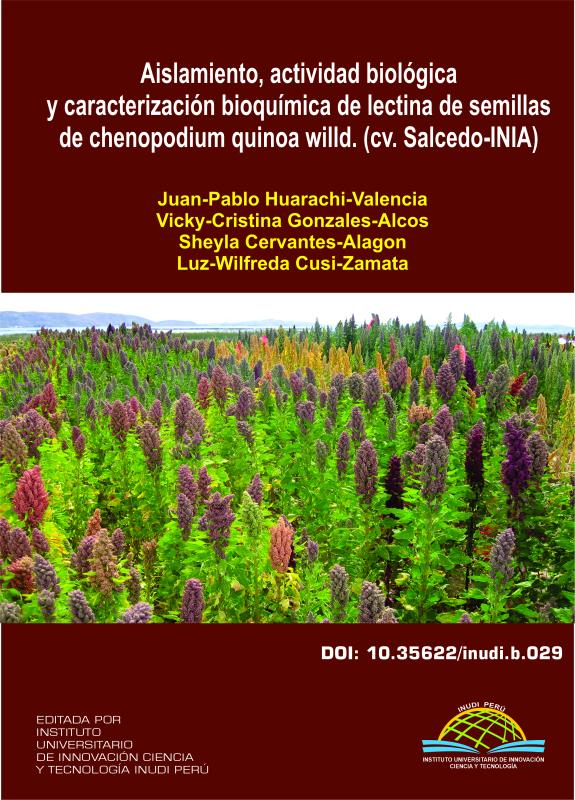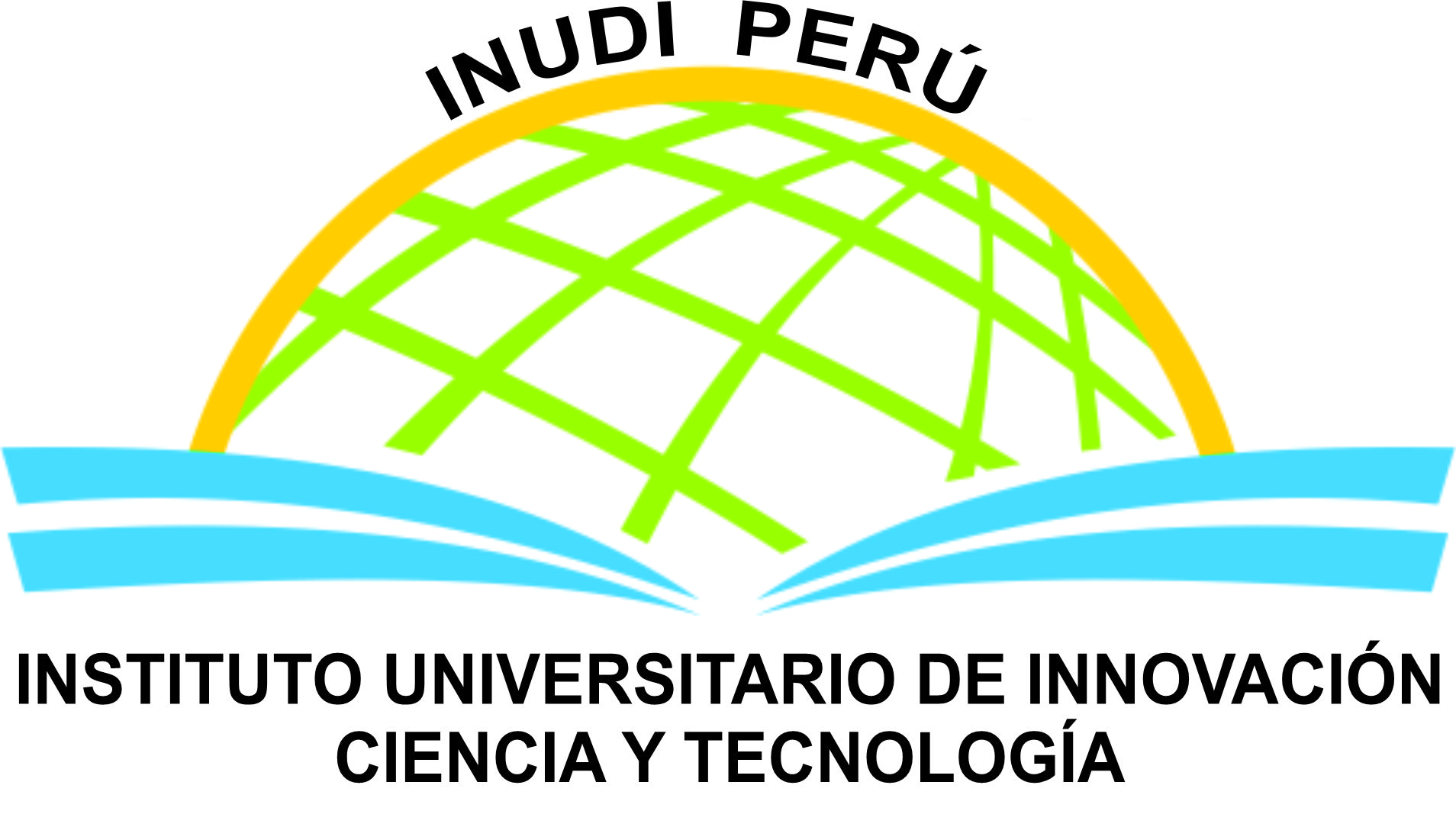Isolation, biological activity and biochemical characterization of lectin from chenopodium quinoa willd seeds. (cv. Salcedo-INIA)
Keywords:
lectin, Chenopodium quinoa, bactoagglutination, insecticidal activitySynopsis
Lectins act as cell recognition molecules, and probably in plant defense. The CqLEC, lectin from Ch. quinoa cv Salcedo INIA, was isolated, purified and characterized from 70 g of seeds through saline extraction, and the combination of two molecular exclusion chromatographies such as Sephadex G-100 and G -75, obtaining 5.53 mg/ml of protein with hemagglutinating activity, as well as by reverse phase HPLC at 32 minutes with 54% buffer B, indicating that it had a low number of hydrophobic residues in its structure. Likewise, SDS-PAGE showed that the purified lectin was homogeneous since it had a single component corresponding to a 12.82 kDa protein. Being that the CqLEC agglutinated human erythrocytes of the “O Rh+” blood group with an MHC of 1.95 μg/ml, inhibited by fucose (0.78 mM) and the chelating agent EGTA (0.1 mM), this indicated that would be a fucose-binding lectin dependent on divalent ions such as calcium or manganese. On the other hand, this protein showed specific bactoagglutination for E. coli (CMB equal to 200 μg/ml), as well as insecticidal activity against Symmetrischema plaesiosema larvae (1000 ppm of CqLEC, P < 0.05). Complete amino acid analysis revealed that CqLEC is an acidic lectin (70.54% hydrophilic residues and 29.46% hydrophobic residues), with glutamic acid (33%) prevailing, with a molecular mass of 12.859 kDa. By sequential homology study, it was determined that it belongs to the family of vegetable lectins of Legumes, showing 82.1% similarity with the precursor of agglutinin I extracted from the bark of Cladrastis kentukea. The CqLEC also presented highly conserved residues in its structure, such as Leu 4, Ser 6 and Phe 7.
References
Adar, R. & Sharon, N. (1996). Mutational studies of the amino acid residues in the combining site of Erythrina corallodendron lectin. Eur J Biochem. 239 (3): 668-674.
Ali, N. (1991). Soluble -galactoside binding lectins: physicochemical and functional properties. Biochem. Edu. 19: 2-6.
Álvarez, D., De la Fuente, J., Villarubia, O., Menéndez, J. y Ortiz, E. (2003). Actividad biológica de Ricinus communis sobre mosca doméstica (Musca domestica). Rev. Cubana Med. Trop. 48 (3): 192-194.
Ayala, C. (1977). Efecto de localidades en el contenido de proteínas en quinua (Chenopodium quinoa Willd.). Tesis de Ing. Agro. Facultad de Agronomía. Universidad Nacional Técnica del Altiplano. Puno - Perú.
Ayouba, A., Causse, H., Van Damme, E., Peumans W., Cambillau, C. & Rougé, P. (1994). Interactions of plant lectins with the components of the bacterial cell wall peptidoglycan. Biochem Syst Ecol. 22: 153-159.
Bao, J., Wu, C., Zhang, J., Lu, H., Wang, K. & Long, H. (2001). The characterization and biological activity of Lycoris radiata agglutinin – a lectin F. 19th INTERLEC. Brazil.
Barbieri, L., Battelli, M. & Stirpe, F. (1993). Ribosome-inactivating proteins from plants. Biochim Biophys Acta. 1154 (3-4): 237-282.
Barondes, S., Cooper, D., Gitt, M. & Leffler, H. (1994). Galectins. Structure and function of a large family of animal lectins. J Biol Chem. 269 (33): 20807-20810.
Bertero, H., King, R. & Hall, A. (1999). Photoperiod-sensitive development phases in quinoa (Chenopodium quinoa Willd.). Field Crops Res. 60: 231-243.
Bidlingmeyer, B., Cohen, S. & Tarvin, T. (1984). Rapid analysis of amino acids using precolumn derivatization. J.Chromat. 33: 93-104.
Bing, D., Weyand, J. & Stavitsky, A. (1967). Hemagglutination with aldehyde-fixed erythrocytes for assay of antigens and antibodies. Proc Soc Exp Biol Med. 124 (4): 1166-1170.
Birren, B. (2003). Direct Submission. Submitted Whitehead Institute/MIT Center for Genome Research, 320 Charles Street, Cambridge, MA 02142. USA.
Blake, C. & Johnson, L. (1984). Protein structure. TIBS. 147-151.
Blanco, Je., Blanco, M., Blanco, J., Mora, A., Balaguer, L., Mouriño, M., Juárez, A. & Jansen, W. (1996). O serogroups, biotypes and eae genes in Escherichia coli isolated from diarrheic and healthy rabbits. J. Clin. Microbiol. 34: 3101-3107.
Bohlool, B. & Schmidt, E. (1974). Lectins: A possible basis for specificity in the Rhizobium-legume root nodule symbiosis. Science. 185: 269-271.
Broekaert, W. & Peumans, W. (1986). Lectin release from seeds of the Datura stramonium and interference of the Datura stramonium lectin with bacterial motility. In TC Bog-Hansen, E Van Driessche, eds, Lectins, Biology, Biochemistry, Clinical Biochemistry, Vol 5. Walter de Gruyter, Berlin, pp 57-65.
Broekaert, W., Van Parijs, J., Leyns F., Joos H. & Peumans, W. (1989). A chitin-binding lectin from stinging nettle rhizomes with antifungal properties. Science. 245: 1100-1102.
Broekaert W., Marien W., Terras F., De Bolle M., Proost P., Van damme J., Dillen L., Claeys M., Rees S., Vanderleyden J. & Cammue B. (1992). Antimicrobial peptides from Amaranthus caudatus seeds with sequence homology to the cysteine/glycine-rich domain of chitin-binding proteins. Biochemistry. 31: 4308-4314.
Carvalho M. & Sgarbieri V. (1998). Relative importance of phytohemagglutinin (lectin) and trypsin-chymotrypsin inhibitor on bean (Phaseolus vulgaris L) protein absorption and utilization by the rat. J Nutr Sci Vitaminol (Tokyo). 44 (5): 685-696.
Carvalho D., Marangoni S., Oliveira B. & Novello J. (1998). Isolation and characterization of a new lectin from the venom of the snake Bothrops jararacussu. Biochem. Mol. Biol. Inter. 44 (5): 933-938.
Ceccatti, J. (2004). Resisting insects: shifting strategies in chemical control. Endeavour. 28 (1): 14-19.
Chothia, C. (1984). Principles that determine the structure of proteins. Ann. Rev. Biochem. 53: 537-572.
Chrispeels, M. & Raikhel, N. (1991). Lectins, Lectin genes, and their role in plant defense. Plant Cell. 3: 1-9.
Collinge, D., Kragh, K., Mikkelsen, J., Nielsen K., Rasmussen, U. y Vad, K. (1993). Plant chitinases. Plant J. 3: 31-40.
Costa, F., Sampaio, A., Neves, S., Rocha, M., Benavides, M. & Freitas, A. (1999) Purification and characterization of a lectin from the red marine alga Amansa multifida. Physiol. Mol. Biol. Plants. 5: 53-61.
Coulter, L. & Lorenz, K. (1990). Quinoa, composition nutritional value, food application. Lebensmittel-Wissenschaft Technologie. 3: 203-207.
Czapla, T. & Lang, B. (1990). Effect of plant lectins on the larval development of European corn borer (Lepidoptera: Pyralidae) and Southern corn rootworm (Coleoptera: Chrysomelidae). J. Econ. Entomol. 83: 2480-2485.
De Miranda Santos, I. & Pereira, M. (1984). Lectins discriminate between pathogenic and nonpathogenic South American trypanosomes. Am J Trop Med Hyg. 33 (5): 839-844.
Diaz, C., Melchers, L., Hooykaas, P., Lugtenberg, B. & Kijne, J. (1989). Root lectin as a determinant of host-plant specificity in the Rhizobium-legume simbiosis. Nature. 338: 579-581.
Drickamer, K. (1988). Two distinct classes of carbohydrate-recognition domains in animal lectins. J Biol Chem. 263(20): 9557-9560.
Drickamer, K., Dordal, M. & Reynolds, L. (1986). Mannose-binding proteins isolated from rat liver contain carbohydrate-recognition domains linked to collagenous tails. Complete primary structures and homology with pulmonary surfactant apoprotein. J Biol Chem. 261(15): 6878-6887.
Edman, P. & Begg, G. (1967). A protein sequenator. Eur J Biochem.1: 80-91.
Etzler, M. (1986). Distribution and function of plant lectins. In the Lectins, I.E. Liener, N. Sharon, e I.J. Goldstein, eds (San Diego; Academic Press), pp. 371-435.
Fountain, D., Foard, D., Replogle, W. & Yang, W. (1977). Lectin release by soybean seeds. Science. 197: 1185-1187.
Freire, M., Machado, O., Smolka, M., Marangoni, S., Novello, J. & Macedo M. (2001a). Isolation and characterization of isolectins from Talisia esculenta seeds. J. Protein. Chem. 20 (6): 495-500.
Freire, M., Silva, A., Lima, M., Marangoni, S., Novello, J. & Macedo, M. (2001b). TEL a novel lectin from Talisia esculenta seeds: isolation and cell migration inducing. 19th INTERLEC. Brazil.
Gabius, H. (1994). Non-carbohydrate binding partners/domains of animal lectins. Int J Biochem. 26 (4): 469-477.
Gandarillas, H. & Luizaga J. (1969). Número de cromosomas de Chenopodium quinoa Willd. en radículas y raicillas. Turrialba 17 (3): 275-279.
Girbes, T., Ferreras, J., Iglesias, R., Citores, L., De Torre, C., Carbajales, M., Jiménez, P., De Benito, F. & Muñoz, R. (1996). Recent advances in the uses and applications of ribosome-inactivating proteins from plants. Cell Mol Biol. 42 (4): 461-471.
Goldstein, I. & Hayes, C. (1978). The lectins: Carbohydrate binding proteins of plants and animals. Adv. Carbohydr. Chem. Biochem. 35: 127-340.
Grant, G., More, L., Mckenzie, N., Dorward, P., Stewart, J., Telek, Y. & Pusztai, A. (1991). A survey of the nutritional and haemagglutination properties of several tropical seeds. Livestock Research for Rural Development. Vol. 3, N° 3.
Guinée, P., Agterberg, C. & Jansen, W. (1972). Escherichia coli O antigen typing by means of a mechanized microtechnique. Appl. Microbiol. 24:127-131.
Henrikson, R. & Meredith, S. (1984). Amino acid analysis by reverse-phase high performance liquid chromatography in differentiating mouse astrocytes in primary culture. Dev. Neurosci. 1:226 -267.
Hirabayashi, J., & Kasai, K. (1991). Effect of amino acid substitution by sited-directed mutagenesis on the carbohydrate recognition and stability of human 14-kDa beta-galactoside-binding lectin. J Biol Chem. 266 (35): 23648-23653.
Hoffman, L. & Donaldson, D. (1985) Characterization of two Phaseolus vulgaris phytohemagglutinin genes closely linked on the chromosome. EMBO J. 4: 883-889.
Hudak, K., Wang, P. & Tumer, N. (2000). A novel mechanism for inhibition of translation by pokeweed antiviral protein: depurination of the capped RNA template. RNA 6: 369–380.
Huesing, J., Murdock, L. & Shade, R. (1991a). Effect of wheat germ isolectins on development of cowpea weevil. Phytochemistry. 30: 785-788.
Huesing, J., Murdock, L. & Shade, R. (1991b). Rice and stinging nettle lectins: insecticidal activity similar to wheat germ agglutinin. Phytochemistry. 30: 3565-3568.
Hynes, S., Hirmo, S., Wadström, T. & Moran, A. (1999). Differentiation of Helicobacter pylori isolates based on lectin binding of cell extracts in an agglutination assay. Journal of Clinical Microbiology. 37 (6): 1994-1998.
INIA (1997). "El cultivo de quinua Chenopodium quinoa Wild". Serie plegable Nº 7-97. Lima-Perú.
Jiro, D., Silva, J., Novello, J. & Marangoni, S. (2002). Purificação, caracterização bioquímica e funcional de lectinas em sementes de Chenopodium quinoa. X Congresso Interno de Iniciacao Científica da UNICAMP. Brazil.
Kini, R. (1996). Are C-type lectin-related proteins derived by proteolysis of metalloproteinase/disintegrin precursor proteins?. Toxicon. 34 (11-12): 1287-1294.
Kolberg, J. & Sletten, K. 1982 Purification and properties of a mitogenic lectin from Lathyrus sativus seeds. Biochim Biophys Acta. 704 (1): 26-30.
Konishi, Y., Hirano, S., Tsuboi, H. & Wada, M. (2004). Distribution of minerals in quinoa (Chenopodium quinoa Willd.) seeds. Biosci. Biotechnol. Biochem. 68 (1): 231-234.
Koziol, M. (1992). Chemical composition and nutritional evaluation of quinoa (Chenopodium quinoa Willd.). J. Food Comp. Anal. 5: 35-68.
Laemmli, U. (1970). Cleavage of structural proteins during the assembly of the head of bacteriophage T4. Nature. 227 (259): 680-685.
Leite, K., Ramos, M., Castellón, R., Maia, C., Gurgel, M., Souza, L. & Cavada, B. (2001). Purification, chemical and inmunochemical properties of a nw lectin from Mimosoideae (Parkia discolor). 19th INTERLEC. Brazil.
Lerouge, P., Roche, P., Faucher, C., Maillet, F., Truchet, G., Promé, J. & Denarie, J. (1990). Symbiotic host-specificity of Rhizobium meliloti is determined by a sulphated y acylated of glucosamina oligosaccharide signal. Nature. 344: 781-784.
Lis, H. & Sharon, N. (1986). Lectins as molecules and as tools. Annu Rev Biochem. 55: 35-67.
Lis, H. & Sharon, N. (1987). Erythrina lectins. Methods Enzymol. 138: 544-551.
Loris, R. (2002). Principles of structures of animal and plant lectins. Biochim Biophys Acta. 1572: 198-208.
Mujica, A. (1997). Cultivo de Quinua. Instituto Nacional de Investigación Agraria. Serie Manual RI N° 1-97. Lima-Perú.
Murdock, L., Huesing, J., Nielsen, S., Pratt, R. & Shade, R. (1990). Biological effects of plant lectins on the cowpea weevil. Phytochemistry. 29: 85-89.
Nicholls, C. & Mulley, J. (1982). Distribution of the GC (group-specific component) subtypes in cord bloods and blood donors. Aust J Exp Biol Med Sci. 60 (4): 427-431.
Nowak, T., Haywood, P. & Barondes, S. (1976). Developmentally regulated lectin in embryonic chick muscle and a myogenic cell line. Biochem Biophys Res Commun. 68 (3): 650-657.
Oliveira, J., Melo, V., Camara, M., Vasconcelos, I., Beltramini, L., Machado, O., Gomes, V., Pereira, S., Fernández, C., Nunes, E., Monteiro, A. (2001). Purification and phisicochemical characterization of a legume lectin from Luetzelburgia auriculata. 19th INTERLEC. Brazil.
Olsson, M. & Chester, M. (2001). Polymorphism and recombination events at the ABO locus: a major challenge for genomic ABO blood grouping strategies. Transfusion Medicine. 11 (4): 295-313.
Osborn, T., Alexander, D., Sun, S., Cardone, C. & Bliss, F. (1988). Insecticidal activity and lectin homology of arcelin seed protein. Science. 240: 207-210.
Ozeki, Y., Matsui, T. & Titani, K. (1991). Cell adhesive activity of two animal lectins through different recognition mechanisms. FEBS Lett. 289 (2): 145-147.
Ozeki, Y., Tazawa, E. & Matsui, T. (1997). D-galactoside-specific lectins from the body wall of an echiuroid (Urechis unicinctus) and two annelids (Neanthes japonica and Marphysa sanguinea). Comp Biochem Physiol B Biochem Mol Biol. 118 (1): 1-6.
Pereira, M., Melo, F., Silveira, V., Nascimento, A. & Benevides, N. (2001). Purification and partial characterization of the lectin from the alga Ulva fasciata. 19th INTERLEC. Brazil.
Peumans, W. & Van Damme, E. (1995). Lectins as plant defense proteins. Plant Physiol. 109 (2): 347-352.
Peumans, W., Hao Q. & Van Damme, E. (2001). Ribosome-inactivating proteins from plants: more than RNA N-glycosidases?. The FASEB Journal. 15: 1493-1506.
Peumans, W. & Van Damme, E. (2001). Taxonomical distribution of plant lectins. 19th INTERLEC. Brazil.
Poretz, R., Tang, M. & Vucenik, I. (1986). The separation of lymphocyte subpopulations with lectins. Immunol Invest. 15 (6): 521-529.
Portugal, M., Silva, J., Novello, J. & Marangoni, S. (2002). Estudo da atividade mitogênica da lectina de sementes de Chenopodium quinoa (Cqlec) sobre linfócitos e seu encapsulamento em lipossomos. X Congresso Interno de Iniciacao Científica da UNICAMP. Brazil.
Prakash, D., Nath, P. & Pal, M. (1993). Composition, variation of nutritional contents in leaves, seed protein, fat and fatty acid profile of Chenopodium species. Journal of the Science of Food and Agriculture.62: 203-205.
Prego, I., Maldonado, S. & Otegui, M. (1998) Seed structure and localization of reserves in Chenopodium quinoa. Annals of Botany. 82: 481-488.
Pusztai, A., Ewen, S., Grant, G., Peumans, W., Van Damme, E., Rubio, L. & Bardocz, S. (1990). The relationship between survival and binding of plant lectins during small intestine passage and their effectiveness as growth factors. Digestion. 46: 308-316.
Pusztai, A., Ewen, S., Grant, G., Brown, D., Stewart, J., Peumans, W., Van Damme, E. & Bardocz, S. (1993). Antinutritive effects of wheat-germ agglutinin and other N-acetylglucosamine-specific lectins. Br J Nutr. 70: 313-321.
Ramos, M., Bomfim, L., Becerra, L., Cavada, B., Alencar. N., Santos, C., Grangeiro, T. & Debray, H. (2001). Further characterization of the glycan binding specificity of the lectin from Vatairea macrocarpa and its dependence of pH. 19th INTERLEC. Brazil.
Ranhotra, G., Gelroth, J., Glaser, B., Lorens, K. & Johnson, D. (1993) Composition and nutritional quality of quinoa. Cereal Chemistry. 70: 303-305.
Rossmann, M. &Argos, P. (1981). Protein Folding. Ann. Rev. Biochem. 50: 497-532.
Ruales, J. & Nair, B. (1993). Content of fat, vitamins and minerals in quinoa (Chenopodium quinoa Willd) seeds. Food Chemistry. 48: 131-136.
Sakakibara, F., Kawauchi, H. & Takayanagi, G. (1985). Blood group B-specific lectin of Plecoglossus altivelis (Ayu fish) eggs. Biochim Biophys Acta. 841 (1): 103-111.
Sanabria, E., Vega, N. & Pérez, G. (2001). Isolation and characterization of a lectin from Lepechinia bullata seeds. 19th INTERLEC. Brazil.
Schalla, W., Rice, R., Biddle, J., Jeanlouis, Y., Larsen, S. & Whittington, W. (1985). Lectin characterization of gonococci from an outbreak caused by penicillin-resistant Neisseria gonorrhoeae. J Clin Microbiol. 22 (4): 481-483.
Schlumbaum, A., Mauch. F., Vögeli, U. & Boller, T. (1986). Plant chitinases are potent inhibitors of fungal growth. Nature. 324: 365-367.
Sequeira, L. & Graham, T. (1977). Agglutination of avirulent strains of Pseudomonas solanacearum by potato lectin. Physiol Plant Pathol. 11: 43-54.
Sharon, N. (1983). Lectin receptors as lymphocyte surface markers. Adv Immunol. 34: 213-298.
Sharon, N. (1993). Lectin-carbohydrate complexes of plants and animals: an atomic view. Trends Biochem Sci. 18 (6): 221-226.
Sharon, N. & Lis, H. (1972). Lectins: cell-agglutinating and sugar-specific proteins. Science. 177 (53): 949-959.
Sharon, N. & Lis, H. (1989). Lectins as cell recognition molecules. Science. 246 (4927): 227-234.
Shewry, P., Napier, J. & Tatham, A. (1995). Seed storage proteins: Structures and Biosynthesis. The Plant Cell. 7: 945-956.
Sinclair, T., Purcell, L. & Sneller, C. (2004). Crop transformation and the challenge to increase yield potential. Trends Plant Sci. 9 (2): 70-75.
Swiss Prot: www.ncbi.nim.nih.gov
Taylor, M. & Drickamer, K. (1993). Structural requirements for high affinity binding of complex ligands by the macrophage mannose receptor. J Biol Chem. 268 (1): 399-404.
Toyama, M., Carneiro, E., Marangoni, S., Amaral, M., Velloso, L. & Boschero, A. (2001). Isolation and characterization of a convulxin-like protein from Crotalus durissus collilineatus venom. J. Prot. Chem. 20 (7): 585-591.
Ueno, M., Ogawa, H., Matsumoto, I. & Seno, N. (1991). A novel mannose-specific and sugar specifically aggregatable lectin from the bark of the Japanese pagoda tree (Sophora japonica). J. Biol. Chem. 266 (5): 3146-3153.
Van Damme, E., Barre, A., Bemer, V., Rouge, P., Van Leuven, F. & Peumans, W. (1995). A lectin and a lectin-related protein are the two most prominent proteins in the bark of yellow wood (Cladrastis lutea). Plant Mol. Biol. 29 (3): 579-598.
Van Damme, E., Barre, A., Rouge, P. & Peumans, W. (1997a). Molecular cloning of the bark and seed lectins from the Japanese pagoda tree (Sophora japonica). Plant Mol. Biol. 33 (3): 523-536.
Van Damme, E., Van Leuven, F., & Peumans, W. (1997b). Isolation, characterization and molecular cloning of the bark lectins from Maackia amurensis. Glycoconj. J. 14 (4): 449-456.
Van Parijs, J., Broekaert, W., Goldstein, I. & Peumans, W. (1991). Hevein: an antifungal protein from rubber-tree (Hevea brasiliensis) latex. Plant. 183: 258-262.
Van Parijs, J., Joosen, H., Peumans, W., Geuns, J. &Van Laere, A. (1992). Effect of the lectin UDA (Urtica dioica agglutinin) on germination and cell wall formation of Phycomyces blakesleeanus Burgeff. Arch. Microbiol. 158: 19-25.
Varriano-Marston E. y De Francisco A. 1984 Ultrastructure of quinoa fruti (Chenopodium quinoa Willd.). Food Microstruct. 3: 165-173.
Vilarrubia, O., Dubet, M., Menéndez, J., De la Fuente, J. y Noa, E. (1995). Estudios de 2 preparados de fitohemaglutinina obtenidos por diferentes métodos. Rev. Cienc. Biol. (en prensa).
Villacorta, L. & Talavera, V. (1976). Anatomía del grano de quinua (Chenopodium quinoa Willd.) Anales científicos. Vol. XIV: 39-45. Universidad Nacional Agraria. Lima - Perú.
Wilson, H. (1988). Allozyme variation and morphological relationships of Chenopodium hircinum. Syst. Bot. 13 (2): 215 – 228.
Wu, C., Lu, H., Bao, J., Long, H. & Wang, K. (2001). Purification and characterization of Zephyranthes canadia herb lectin. 19th INTERLEC. Brazil.
Yamamoto, K., Konami, Y. & Irimura, T. (1997). Sialic acid-binding motif of Maackia amurensis lectins. J. Biochem. 121 (4): 756-761.
Yan, B., Ma, Z., Wang, L., Chai, H. & Huang, X. (2000). Direct Submission. Submitted (05-JUL-2000) Biotechnology Research Institute, Yunnan Academy of Agricultural Sciences, Kunming, Yunnan 650205, P.R. China.
Zatta, P., Nyame, K., Cormier, M., Mattox, S., Prieto, P., Smith, D. & Cummings, R. (1991). A solid-phase assay for beta-1,4-galactosyltransferase activity in human serum using recombinant aequorin. Anal Biochem. 194 (1): 185-191.
Zhu, K., Shade, R., Koiwa, H., Salzman, R., Narasimhan, M., Bressan, R., Hasegawa, P. & Murdock, L. (1998). Carbohydrate binding and resistance to proteolysis control insecticidal activity of Griffonia simplicifolia lectin II. Plant Biology. 95: 15123-15128.

















